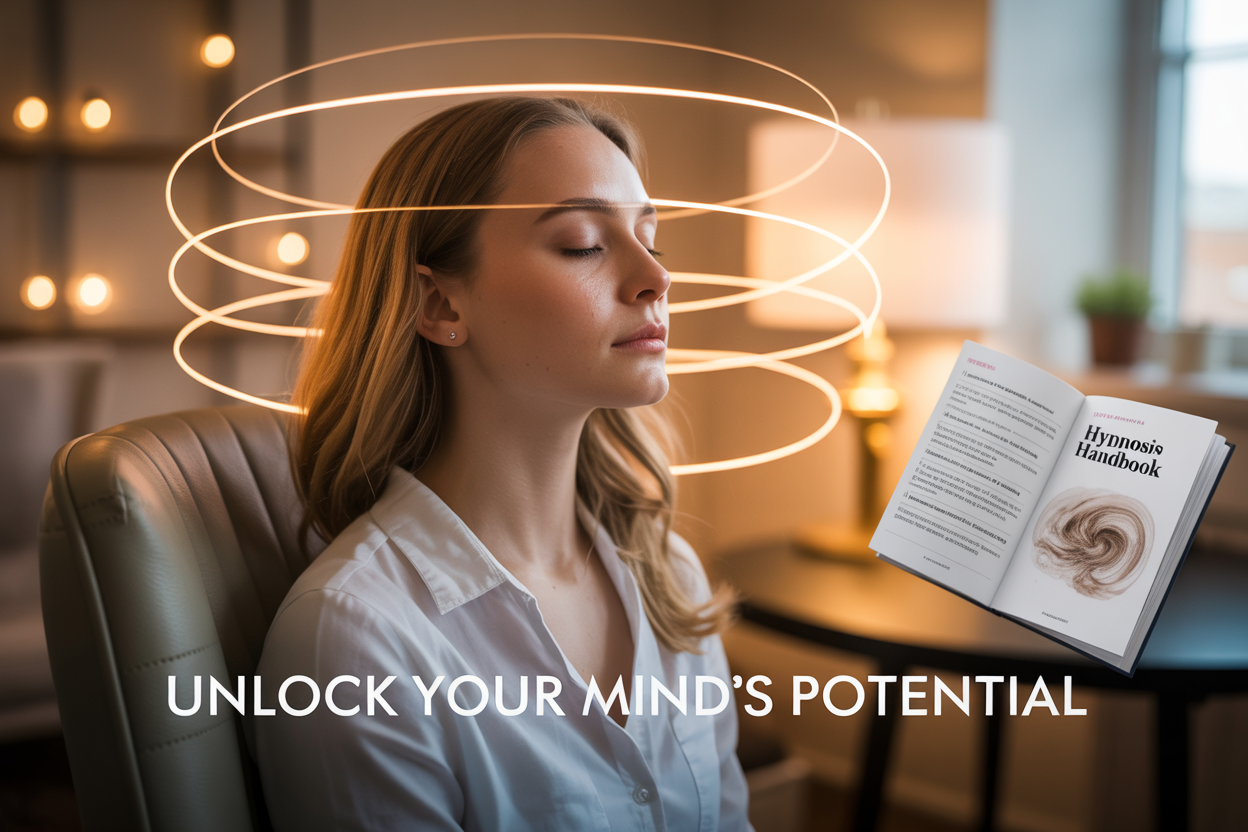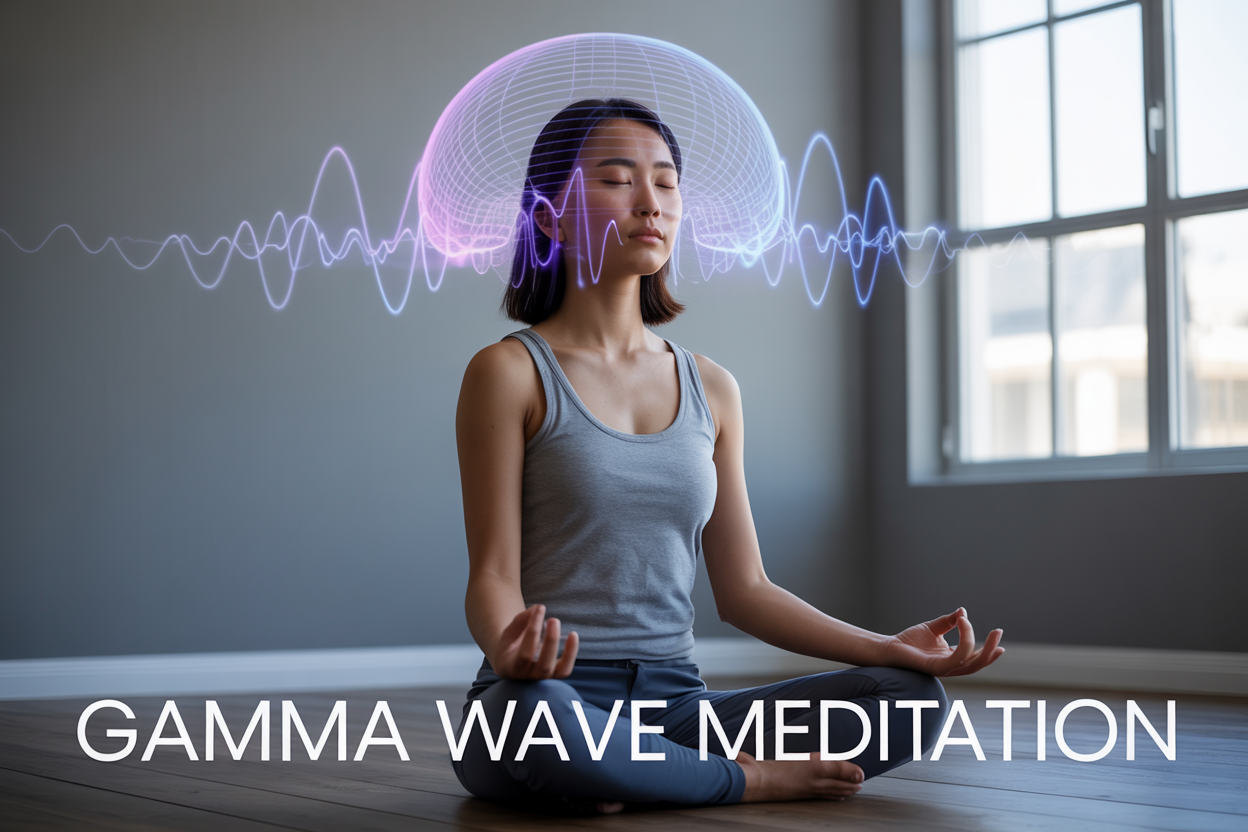Your mind holds incredible power to reshape your reality, break limiting patterns, and create lasting change. Hypnosis techniques offer a scientifically-backed pathway to tap into this potential and transform how you think, feel, and act.
This self-hypnosis guide is designed for anyone ready to take control of their personal growth journey. You might be struggling with confidence, stuck in unwanted habits, or simply curious about mind power techniques that can boost your success and well-being.
We’ll start by exploring the proven benefits of hypnosis for personal development and how these practices actually rewire your brain for positive change. You’ll then learn essential self-improvement techniques, including how to craft hypnotic suggestions that create real, measurable results in your daily life. Finally, we’ll cover advanced applications that can help you unlock your mind’s potential in areas like career success, relationships, and overall life satisfaction.
Get ready to discover why millions of people worldwide use personal development hypnosis as their secret weapon for creating the life they truly want.
Understanding Hypnosis and How It Transforms Your Mind

Debunking Common Myths About Hypnotic States
Hollywood has done a number on hypnosis, painting it as some mystical mind control where people cluck like chickens against their will. The reality? Hypnosis techniques work with your natural mental processes, not against them. You can’t be forced to do anything that goes against your core values or beliefs.
The biggest myth is that hypnotized people lose control. Actually, you remain aware and in charge throughout the entire experience. Think of it like being absorbed in a good book – you’re focused and engaged, but you can put it down anytime. Another common misconception suggests that only “weak-minded” people can be hypnotized. The opposite is true. People with better concentration and imagination typically respond better to self-hypnosis guide practices.
Some worry they might get “stuck” in hypnosis, but your brain naturally returns to normal waking consciousness. It’s like waking up from a daydream – it happens automatically when you’re ready.
The Science Behind Brainwave Changes During Hypnosis
Your brain operates on different frequencies, measured in hertz, that correspond to various states of consciousness. During hypnosis, specific mind transformation occurs at the neurological level that scientists can now measure and observe.
Beta waves (13-30 Hz) dominate your normal waking state when you’re alert and focused. As you enter hypnosis, these shift toward alpha waves (8-13 Hz), the same frequency present during relaxed awareness and light meditation. Deeper hypnotic states produce theta waves (4-8 Hz), associated with deep creativity, memory consolidation, and profound relaxation.
Brain imaging studies reveal fascinating changes during hypnotic states. The anterior cingulate cortex, responsible for attention and emotional regulation, shows increased activity. Meanwhile, the dorsolateral prefronecortex, your inner critic and analytical mind, quiets down. This creates the perfect environment for hypnotic suggestions to bypass mental resistance and create lasting change.
The default mode network, active when your mind wanders, also shifts during hypnosis. This network reorganization explains why people often experience enhanced focus, reduced self-consciousness, and increased openness to positive suggestions during hypnotic states.
How Hypnosis Differs from Sleep and Meditation
While hypnosis shares some similarities with sleep and meditation, each represents a distinct state of consciousness with unique characteristics and benefits for personal development hypnosis.
Sleep involves complete unconsciousness where you can’t respond to external stimuli or directions. In contrast, hypnosis maintains a thread of awareness that allows you to hear and process suggestions while remaining deeply relaxed. Your mind stays receptive and responsive throughout the hypnotic experience.
Meditation typically focuses on present-moment awareness, observing thoughts without judgment, or concentrating on a single point of focus like breath or a mantra. Hypnosis, however, is goal-oriented and purposeful. It uses relaxation as a vehicle to unlock mind potential through specific suggestions designed to create behavioral or perceptual changes.
| State | Awareness Level | Primary Purpose | Responsiveness |
|---|---|---|---|
| Sleep | Unconscious | Physical restoration | None |
| Meditation | Present-focused | Mindfulness/clarity | Limited |
| Hypnosis | Selective awareness | Goal achievement | High |
The brainwave patterns also differ. While meditation often maintains alpha waves, hypnosis can access deeper theta states more readily. This allows for greater plasticity and openness to change-oriented suggestions that support self-improvement through hypnosis.
Your Brain’s Natural Ability to Enter Hypnotic States
Every day, your mind naturally drifts into hypnotic-like states without you realizing it. That moment when you’re driving and suddenly arrive at your destination without remembering the journey? That’s highway hypnosis – a natural trance state where your subconscious handles routine tasks while your conscious mind wanders.
You experience similar states when completely absorbed in a movie, lost in a book, or daydreaming. These natural trance states demonstrate your brain’s inherent capacity for hypnosis for success and personal transformation. Your nervous system is already wired for these experiences.
The hypnagogic state, that drowsy period between wakefulness and sleep, represents another natural hypnotic state. During this time, your mind becomes highly suggestible and creative. Many breakthrough ideas and solutions emerge during these twilight moments of consciousness.
Children enter hypnotic states easily through imaginative play, storytelling, and fantasy. As adults, we retain this ability but often overlook it due to our analytical, busy minds. Mind power techniques simply help you access and direct these natural mental processes intentionally.
The key insight is that hypnosis doesn’t create an artificial state – it amplifies and focuses a natural human capacity you already possess. Your brain continuously shifts between different levels of consciousness throughout the day. Learning to recognize and intentionally access these states opens up powerful possibilities for personal growth and positive change.
Proven Benefits of Hypnosis for Personal Development

Boosting Confidence and Self-Esteem Through Suggestion
Hypnosis offers a direct pathway to rewiring the negative self-talk that keeps many people stuck in cycles of low confidence. When you enter a hypnotic state, your conscious mind’s critical filter relaxes, allowing positive suggestions to reach your subconscious more effectively. This process helps replace limiting beliefs with empowering ones that support your personal growth.
Research shows that self-hypnosis techniques can significantly improve confidence levels by accessing the same mental state where many of our self-limiting beliefs were originally formed. During hypnosis sessions focused on confidence building, you can implant suggestions like “I speak with clarity and conviction” or “I trust my abilities completely.” These hypnotic suggestions work by creating new neural pathways that support confident behavior.
The beauty of personal development hypnosis lies in its ability to address the root causes of low self-esteem rather than just surface-level symptoms. Many confidence issues stem from past experiences or inherited thought patterns that operate below conscious awareness. Hypnosis techniques allow you to access these deeper mental programs and rewrite them with more supportive narratives about your capabilities and worth.
Breaking Bad Habits and Creating Positive Patterns
Bad habits operate largely through unconscious programming, making them notoriously difficult to change through willpower alone. Mind transformation through hypnosis works by accessing the subconscious mind where these automatic patterns are stored and maintained. When you’re in a hypnotic state, you can more easily disconnect from the emotional triggers and environmental cues that typically activate unwanted behaviors.
The process involves several key steps. First, hypnosis helps you identify the underlying needs that your bad habits are attempting to meet. Smoking might provide stress relief, while emotional eating could offer comfort. Once these needs are recognized, you can use hypnosis for success to install healthier alternatives that satisfy the same psychological requirements.
Self-hypnosis guide practices often include visualization exercises where you mentally rehearse new, positive behaviors. This mental rehearsal strengthens the neural pathways associated with your desired actions, making them more automatic over time. Studies demonstrate that this approach can be particularly effective for habits like nail-biting, procrastination, and various forms of self-sabotage.
| Bad Habit | Hypnotic Approach | Positive Replacement |
|---|---|---|
| Smoking | Stress release suggestions | Deep breathing exercises |
| Overeating | Emotional regulation | Mindful eating practices |
| Procrastination | Motivation enhancement | Action-oriented mindset |
Enhancing Focus and Mental Clarity
Modern life bombards us with distractions that scatter our mental energy and reduce our ability to concentrate deeply. Mind power techniques through hypnosis can dramatically improve your capacity for sustained attention and clear thinking. The relaxed yet focused state achieved during hypnosis actually mirrors the optimal brain wave patterns associated with peak mental performance.
During hypnotic sessions targeting focus enhancement, specific suggestions help train your mind to filter out irrelevant information and maintain attention on chosen tasks. These hypnosis techniques work by strengthening the prefrontal cortex’s ability to regulate attention while reducing activity in brain regions associated with mind-wandering and distraction.
Regular practice of self-hypnosis for mental clarity creates lasting improvements in cognitive function. Many people report enhanced problem-solving abilities, improved memory retention, and greater mental stamina after incorporating these practices into their routine. The key lies in consistency and using specific suggestions that align with your particular focus challenges.
Self-improvement through hypnosis for mental clarity often includes anchoring techniques, where you associate a specific physical gesture or mental cue with a state of sharp focus. This allows you to quickly access enhanced concentration whenever needed, whether during work projects, study sessions, or creative endeavors.
Improving Sleep Quality and Energy Levels
Sleep disorders and chronic fatigue affect millions of people, often creating a cycle where poor sleep leads to low energy, which then interferes with the ability to achieve restful sleep. Hypnosis benefits for sleep improvement work by addressing both the physical tension and mental chatter that prevent deep, restorative rest.
The relaxation response triggered during hypnosis naturally prepares your body for sleep by reducing cortisol levels and activating the parasympathetic nervous system. Progressive muscle relaxation combined with sleep-focused suggestions helps release physical tension while calming the overactive mind that keeps many people awake at night.
Hypnotic suggestions for better sleep often include imagery of peaceful settings, counting techniques that occupy the conscious mind, and direct suggestions for deep, uninterrupted rest. These approaches help establish healthier sleep patterns by training your subconscious mind to associate bedtime with relaxation rather than worry or excitement.
Energy level improvements through hypnosis often result from both better sleep quality and suggestions that enhance your body’s natural energy production. Visualization exercises that imagine energy flowing through your body, combined with suggestions for vitality and alertness during waking hours, can significantly boost your overall energy levels. Many practitioners report feeling more refreshed upon waking and maintaining steady energy throughout the day after regular hypnosis practice.
Essential Techniques for Self-Hypnosis Success

Creating the Perfect Environment for Deep Relaxation
Your surroundings play a massive role in how effectively you can enter a hypnotic state. Start by finding a quiet space where you won’t be interrupted for at least 20-30 minutes. Turn off your phone, close the door, and let family members know you need some uninterrupted time.
Temperature matters more than you might think. Keep your room slightly cool, around 65-70°F, as warmth can make you drowsy rather than deeply relaxed. Dim the lights or use blackout curtains to create a peaceful atmosphere. Many people find that soft, instrumental music or nature sounds help them relax, while others prefer complete silence.
Choose comfortable seating that supports your body without making you so cozy that you fall asleep. A reclining chair works perfectly, but you can also lie down on your bed with a pillow under your knees. Wear loose, comfortable clothing that doesn’t restrict your breathing or circulation.
Consider using aromatherapy to enhance your relaxation response. Lavender, chamomile, or sandalwood can trigger your brain’s relaxation mechanisms. Keep a glass of water nearby, as some people experience mild thirst after self-hypnosis sessions.
Mastering Progressive Muscle Relaxation Methods
Progressive muscle relaxation forms the foundation of successful hypnosis techniques and helps you achieve the deep physical calm needed for effective self-hypnosis. This method involves systematically tensing and releasing different muscle groups throughout your body.
Start with your toes and work your way up. Curl your toes tightly for 5 seconds, then release and notice the contrast between tension and relaxation. Move to your calf muscles, then your thighs, buttocks, and continue upward. Tense each muscle group for 5 seconds, then release for 10-15 seconds while focusing on the sensation of letting go.
Pay special attention to areas where you typically hold stress. Most people carry tension in their shoulders, jaw, and forehead. When you reach your face, scrunch up all your facial muscles, then let everything go completely slack. Your jaw should drop slightly, and your tongue should rest loosely in your mouth.
The key is learning to recognize the difference between tension and relaxation in your body. With practice, you’ll be able to release muscle tension almost instantly without going through the entire sequence. This mind power technique becomes a powerful trigger that signals your subconscious mind that it’s time to enter a receptive state.
Some people prefer working from head to toe instead of toe to head. Experiment with both directions to see which feels more natural for you. The goal is reaching a state where your body feels heavy, warm, and completely at ease.
Developing Powerful Visualization Skills
Visualization transforms abstract concepts into concrete mental experiences that your subconscious mind can work with effectively. Think of your imagination as a muscle that grows stronger with regular exercise. The more vivid and detailed your mental images become, the more powerful your self-hypnosis guide practice will be.
Begin with simple, familiar scenes. Picture your childhood bedroom, a favorite vacation spot, or even your current kitchen. Include all five senses in your visualization. What do you see, hear, smell, taste, and feel? If you’re imagining a beach, see the blue water and white sand, hear the waves crashing, smell the salt air, taste the ocean breeze on your lips, and feel the warm sand between your toes.
Create a special place in your mind that becomes your go-to relaxation sanctuary. This could be a peaceful forest clearing, a cozy cabin, or even a floating cloud. Visit this place regularly during your practice sessions until it becomes so familiar that you can access it instantly.
For personal development hypnosis, practice visualizing yourself achieving your goals. If you want to become more confident, see yourself walking tall, speaking clearly, and feeling completely at ease in social situations. Make these mental movies as realistic as possible, complete with specific details about your clothing, surroundings, and the reactions of others.
Don’t worry if your mental images seem fuzzy at first. Some people are naturally visual, while others connect more strongly with sounds, feelings, or even internal dialogue. Work with your natural strengths while gradually developing the other senses. The most effective hypnotic suggestions engage multiple senses simultaneously, creating a rich, immersive experience that your mind accepts as real.
Crafting Effective Hypnotic Suggestions for Maximum Impact

Writing Positive and Present-Tense Affirmations
Creating powerful hypnotic suggestions starts with understanding the language your subconscious mind responds to best. Your inner mind operates in the present moment and doesn’t distinguish between what’s real and what’s vividly imagined. This makes positive, present-tense statements incredibly effective for programming lasting change.
Replace phrases like “I will be confident” with “I am confident and calm in every situation.” The difference might seem subtle, but it’s profound. Your subconscious treats future-tense statements as something that may never arrive, while present-tense affirmations create immediate neural pathways for change.
Avoid negative words entirely. Instead of saying “I don’t feel anxious,” your mind focuses on the word “anxious.” Transform this into “I feel peaceful and relaxed.” Your brain can’t process negatives during hypnosis the same way it does in conscious thought, so every word matters.
Keep your hypnotic suggestions specific and action-oriented. Rather than vague statements like “I am better,” use precise language: “I speak clearly and confidently in meetings” or “I sleep deeply through the night, waking refreshed at 7 AM.” Specific suggestions give your subconscious clear instructions to follow.
Personal relevance amplifies effectiveness. Tailor your affirmations to your unique goals and circumstances. Generic suggestions work, but personalized ones that reflect your specific challenges and aspirations create deeper transformation.
Incorporating Sensory Details for Deeper Programming
Your subconscious mind thinks in pictures, sounds, feelings, and sensations. The more sensory details you weave into your hypnosis techniques, the more real and compelling your suggestions become. This approach engages multiple neural pathways simultaneously, creating stronger and more lasting changes.
Paint vivid mental pictures with your words. Instead of simply saying “I am successful,” expand it to “I see myself walking confidently into my office, hearing colleagues praise my innovative ideas, feeling the smooth texture of my promotion letter, and tasting the celebratory coffee that marks my achievement.”
Engage all five senses systematically:
| Sense | Example Integration |
|---|---|
| Visual | “I see bright colors and clear paths ahead” |
| Auditory | “I hear encouraging words and peaceful sounds” |
| Kinesthetic | “I feel strong, grounded, and energized” |
| Olfactory | “I breathe in fresh, clean air that energizes me” |
| Gustatory | “I taste the sweetness of success and satisfaction” |
Temperature and texture add another layer of realism. “I feel the warm sunshine on my face as I confidently present my ideas” creates a more immersive experience than basic affirmations alone.
Movement and spatial awareness deepen the programming process. “I walk tall with steady steps, my shoulders back and my head held high” gives your mind physical anchors for confidence. These kinesthetic elements help translate mental changes into real-world behaviors.
Emotional undertones amplify every suggestion. Pair your sensory details with feelings: “As I feel the firm handshake of my new business partner, warmth and excitement flow through my body, knowing this partnership will flourish.” This combination of sensation and emotion creates powerful associations your mind will naturally seek to recreate.

Hypnosis opens up a world of possibilities when you understand how it works and apply it safely. From boosting your confidence and breaking bad habits to managing stress and improving sleep, the benefits touch every area of your life. The techniques we’ve covered—from basic self-hypnosis methods to crafting powerful suggestions—give you the tools to start your transformation journey today.
Remember, hypnosis isn’t magic, but it’s pretty close when you see the real changes it can create. Start small with simple self-hypnosis sessions, practice regularly, and always keep safety in mind. Your subconscious mind is ready to help you achieve your goals—you just need to learn how to speak its language. Pick one technique from this handbook and try it tonight. Your future self will thank you for taking that first step toward unlocking your mind’s true potential.









